Pastitsio is a traditional Greek pasta bake that’s rich, cheesy, and full of flavour! This recipe features layers of pasta, spiced beef, and a creamy béchamel sauce that’s baked until golden. Trust me, this is Greek comfort food at its finest!
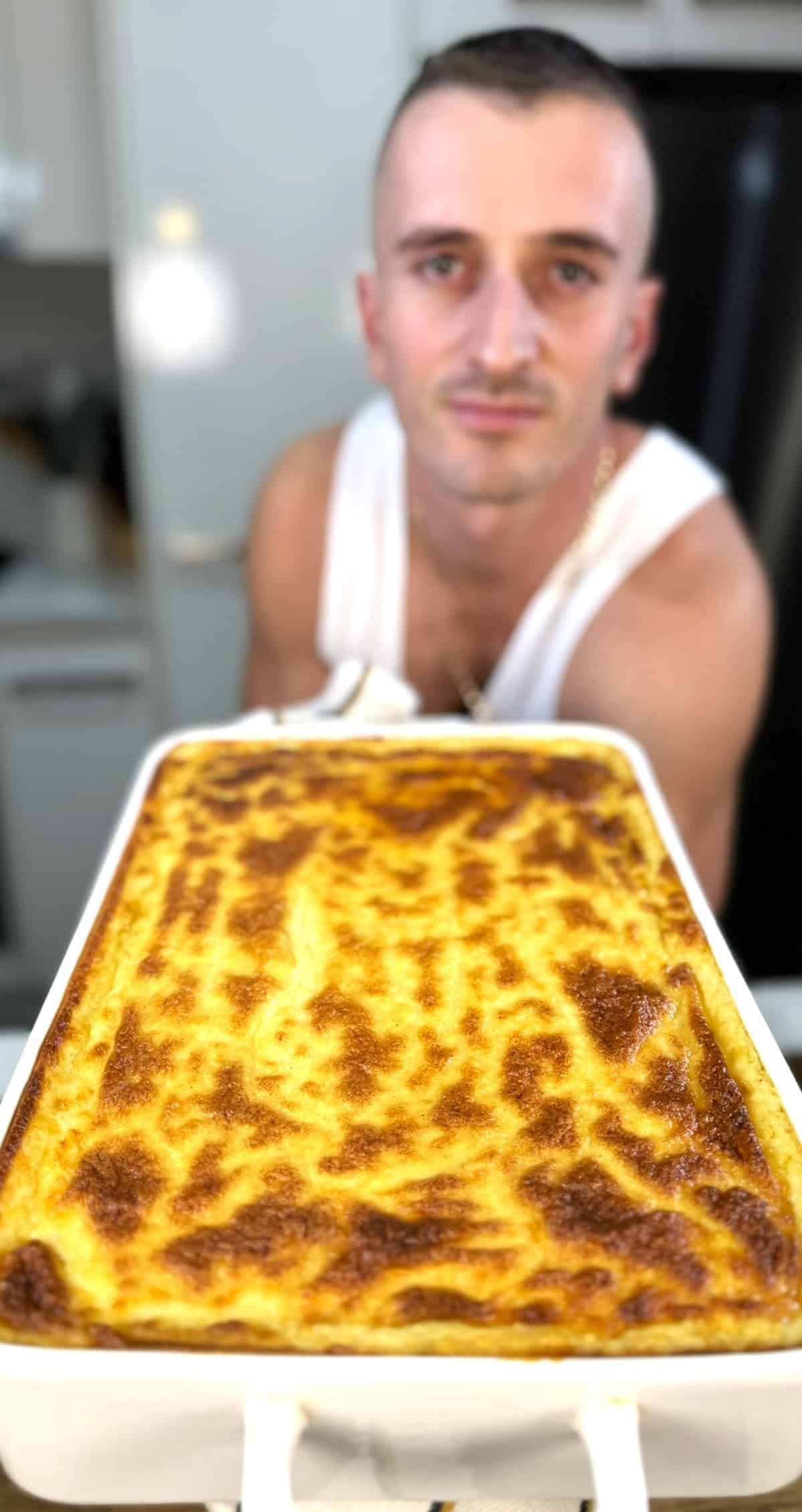
If you love this kind of dish, you’ve got to try my moussaka recipe, another layered Greek classic with spiced meat and creamy béchamel.
But if you’re just on the hunt for other authentic favourites, check out my Greek slow-cooked stuffed roast lamb or my gemista recipe (stuffed vegetables). Both are proper traditional classics and packed with flavour!
Jump to:
Why you will love this recipe
- Proper Greek comfort food: It’s warm, filling, and brings you back to yiayia and papou’s house with every bite. The kind of meal that gets people gathered around the table, talking, laughing, and going back for seconds.
- Looks as good as it tastes: That first slice says it all. You get clean, distinct layers! Pasta on the bottom, meat in the middle, and golden béchamel on top. It holds its shape, smells unreal, and tastes even better than it looks.
- A full-on experience: There’s something about pulling it from the oven, golden on top, and letting it rest before that first perfect slice. It’s a proper labour of love and one of those dishes you feel proud to serve, and even prouder to eat.
- Feeds a crowd: Whether you’ve got the whole family coming over or just want enough food to last a few days, this one delivers. Perfect for special occasions, a small dinner party, or honestly just because.

What is pastitsio?
Pastitsio (pronounced pah-stee-tsee-oh) is a classic Greek pasta dish that’s baked in layers. It's kind of like Italian lasagna, but with its own unique twist. A staple in Greek households made with tubular pasta, a hearty meat sauce, and topped with a thick, creamy béchamel sauce. The whole thing is baked until the top goes golden brown, then sliced into neat, satisfying slabs.
The 3 layers
Some people call it the Greek version of lasagna, and fair enough, but in my opinion, it’s got even more going for it. Here’s a breakdown of the distinct layers in this Greek pastitsio recipe:
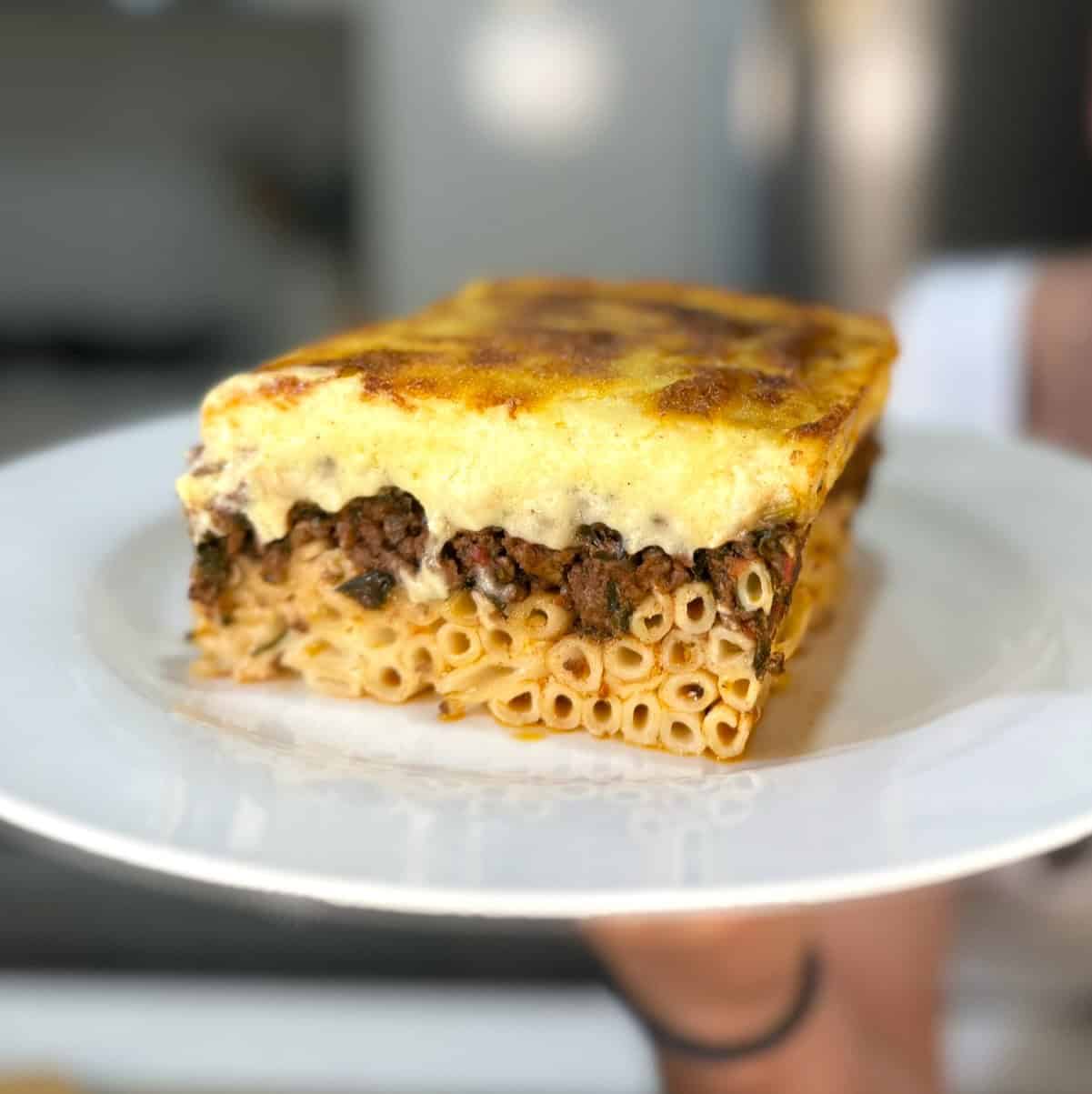
- Pasta: We use tubular pasta like pastitsio pasta no. 2 or thick bucatini-style pasta, which gives structure and holds everything in place. It’s mixed with feta, grated hard cheeses, and egg whites, helping it bake into a firm base that slices clean every time.
- Meat sauce: The meat filling is made with lean ground beef, red wine that adds a deep, bold flavour, and plenty of goodness from crushed tomatoes, herbs, and warm spices like cinnamon and nutmeg. It’s rich, comforting, and full of that slow-cooked taste that makes Greek pastitsio so special.
- Béchamel: The final layer is a smooth, creamy sauce that’s thick and luscious. Once baked, it forms that signature golden brown top, giving it that classic traditional pastitsio look you’ll recognise from every Greek family kitchen.
Watch the short video tutorial
Watch my pastitsio video below and follow along step-by-step to see how all the different components come together to create such a delicious dish.
Don’t forget to subscribe and share this hearty meal with a friend who loves Greek recipes!
Ingredients
Let’s take a look at the ingredients that make this the ultimate Greek comfort food. As always, you’ll find the complete list with exact amounts in the recipe card below.
Meat sauce
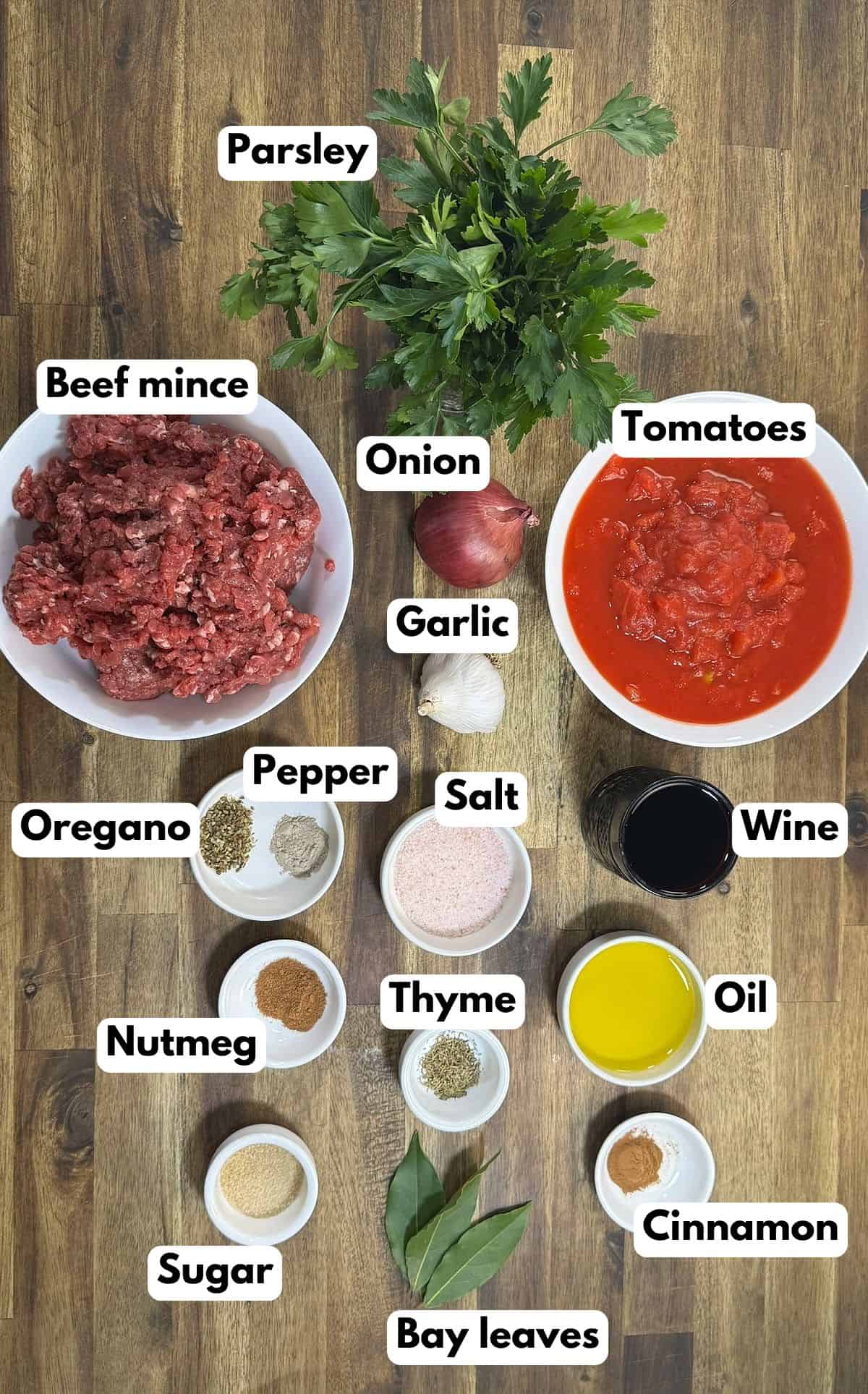
- Olive oil: I recommend a good quality Greek extra virgin olive oil if you’ve got it on hand. It builds that base flavour when softening the onion and garlic.
- Red onion: I usually go for red onion because it adds a bit of sweetness and colour, but any onion will work. Just chop it nice and small.
- Garlic cloves: Fresh garlic is a must! Don’t be scared to throw in a few extra.
- Lean ground beef: I use lean beef to keep it rich without being too greasy, but it still gives all that classic comfort.
- Red wine: Adds boldness, depth, and gives that slow-cooked, proper Greek flavour that makes your kitchen smell beautiful.
- Crushed tomatoes: These form the base of the sauce and bring that rich, slow-cooked flavour. If you like a more intense tomato kick, you can stir in a little tomato paste, but it’s totally optional.
- Spices: A mix of cinnamon, nutmeg, oregano, thyme, and white pepper. The cinnamon brings that signature warmth, and the nutmeg ties in beautifully with the béchamel. The rest gives balance and that unmistakeable Greek taste.
- Bay leaves: Toss a couple in and let them do their thing while the sauce simmers. They bring a gentle earthiness in the background.
- Fresh parsley: Stirred in at the end to freshen things up and give the sauce a bit of lift.
- Sugar and salt: A small pinch of sugar balances the tomatoes, and salt brings everything together. Taste as you go and adjust if needed.
Pasta layer
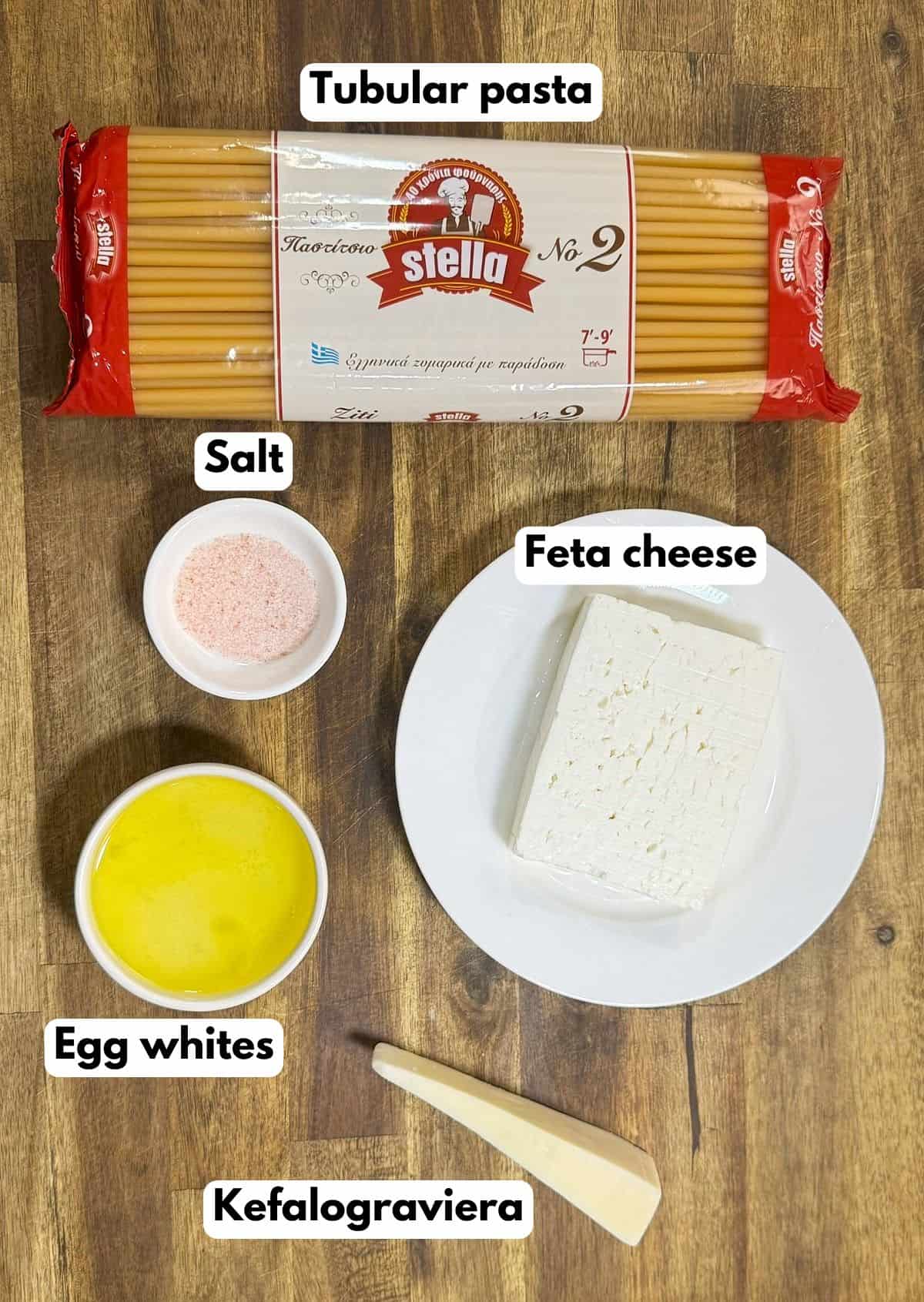
- Pasta (Pastitsio No. 2): These thick pasta tubes have amazing structure and keep their shape and sturdy texture through boiling and baking. That’s what gives you those neat, stacked layers when you slice it. You can use bucatini or penne pasta if you’re struggling to find it.
- Salt: Season the pasta water well so it doesn’t taste flat. It’s a small step that makes a difference in the final dish.
- Greek Feta Cheese: Crumbled through the pasta for salty, creamy pops that melt into the mix.
- Kefalograviera: Grate the cheese finely for even melting and a bit of a sharper cheese kick. If you can’t get your hands on Kefalograviera, Parmesan cheese, Pecorino, Kasseri, or Kefalotyri cheese are all solid swaps.
- Egg whites: These are mixed through the pasta to help it hold together when baked. It’s the little trick that gives you those perfect, clean slices when you serve it up.
Béchamel sauce
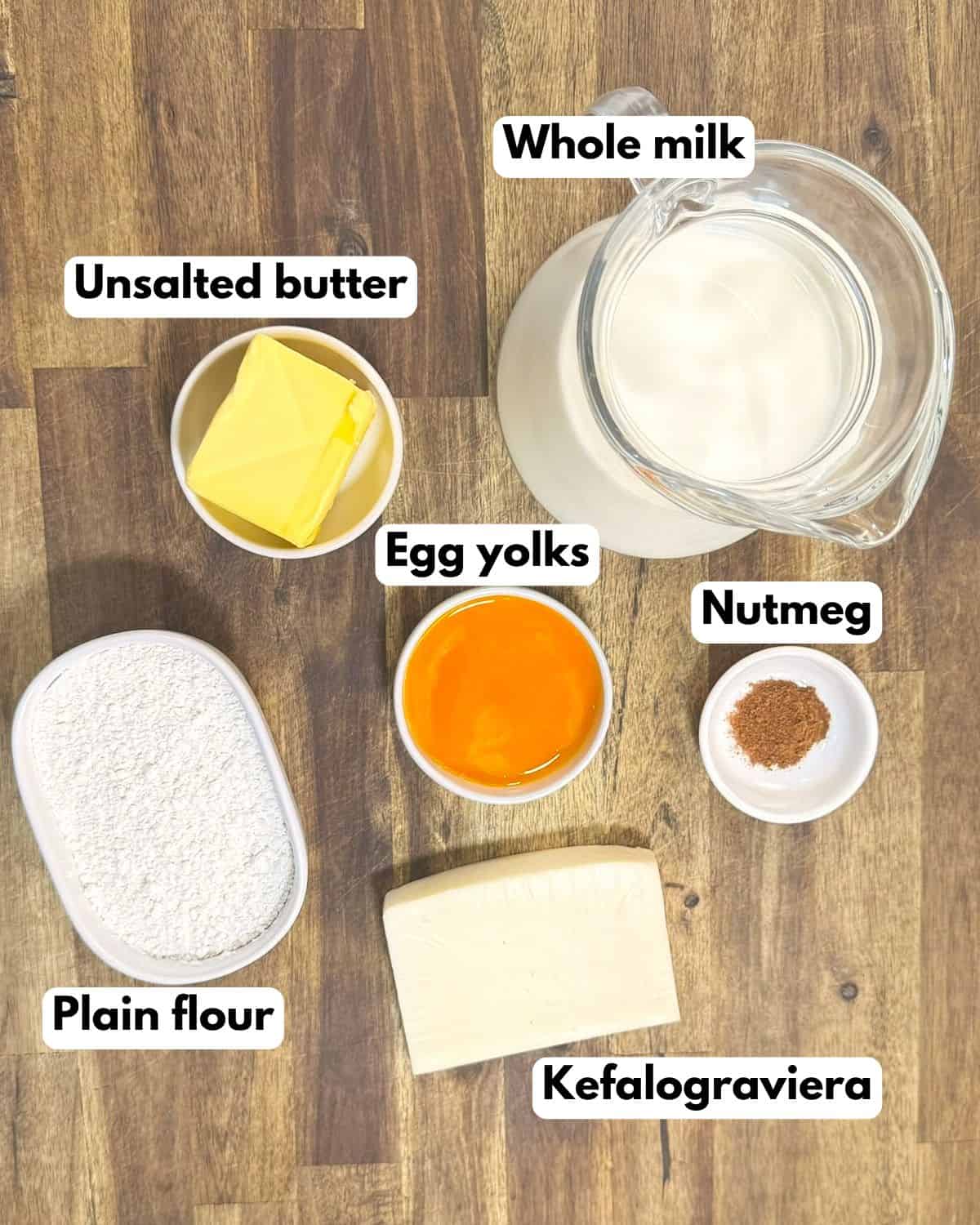
- Unsalted butter: This kicks off your roux, the base of the sauce. I use unsalted because the cheese adds plenty of salt, and this way you don’t go overboard.
- Plain flour: Combined with the butter to form a smooth paste. Keep whisking as it cooks so you don’t end up with lumps.
- Whole milk: Room temperature milk helps everything combine more smoothly and makes the sauce thicken evenly.
- Egg yolks: These add that golden colour and rich texture that makes the béchamel thick and luxurious. With the whites in the pasta, nothing goes to waste!
- Nutmeg: Just a pinch is all you need. It brings that warmth and traditional Greek aroma that balances the richness.
- Grated Kefalograviera: Stir this in at the end so it melts right through the sauce. It gives the béchamel body, saltiness, and that sharp cheese hit that rounds it all out.
Preparation
Getting a few things prepped ahead makes this whole process feel way easier. Here’s what I like to do before I start cooking:
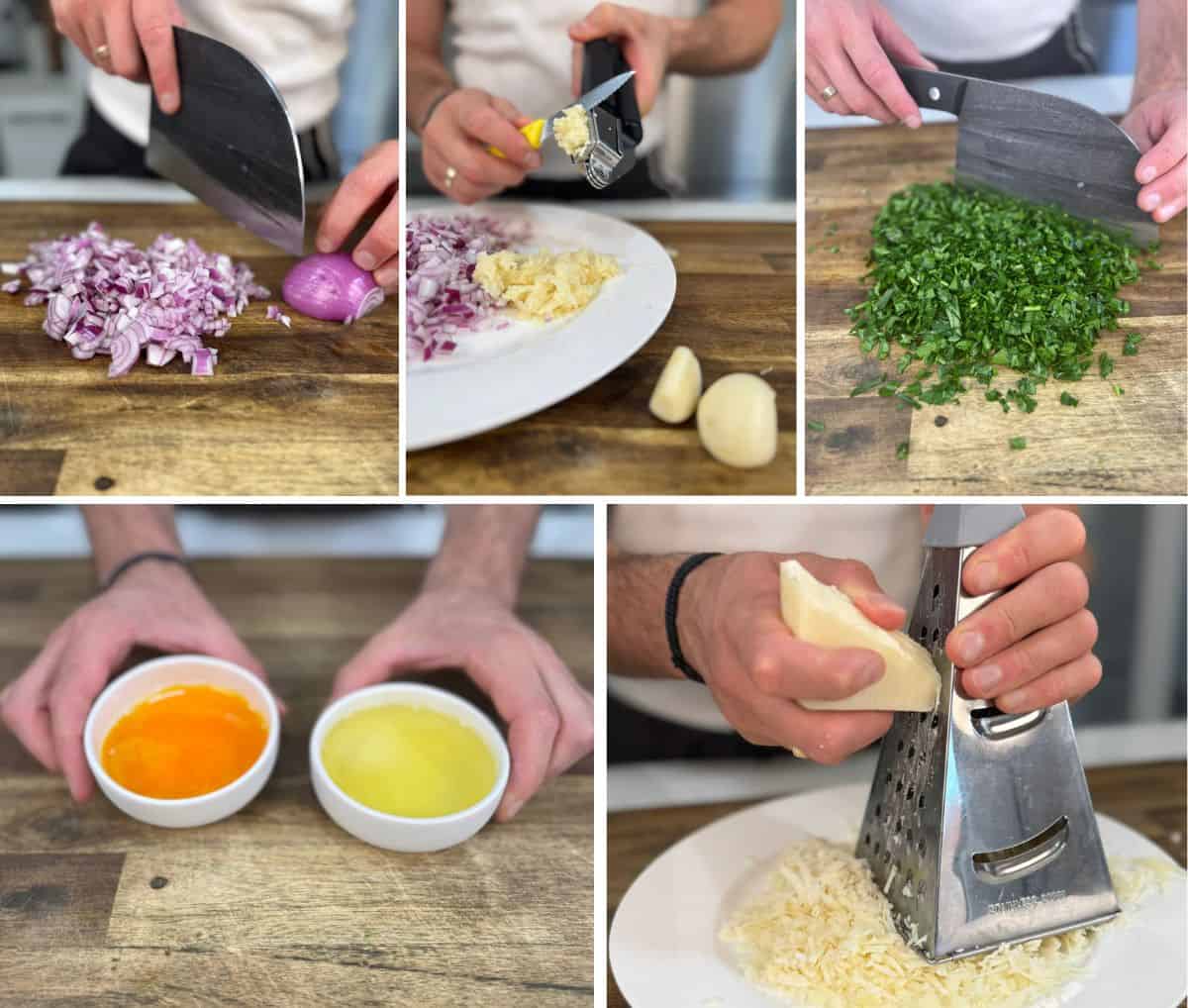
- Chop everything first: Dice the red onion, mince your garlic, and chop the fresh parsley so it's all ready to go when the heat’s on.
- Measure out your spices: It’s way easier to have your spices, salt, and sugar in small bowls ready to go rather than fumbling through the pantry mid-cook.
- Separate your eggs: You’ll need the egg whites for the pasta and the yolks for the béchamel, so separate them early and set them aside.
- Grate the cheese: Whether you're using Kefalograviera, Parmesan, or something else, grate it all now so you’re not stopping halfway to do it.
- Get your dish ready: I use a 36 cm x 24 cm baking/ casserole dish, but anything similar in size will work.
- Grab your tools: You’ll need a wooden spoon for stirring the meat sauce and a whisk for making the béchamel smooth and lump-free.
Step-by-step cooking instructions
Follow these simple steps using the images with their corresponding step! If you get stuck, watch my video for more help and to see the whole cooking method in action!
Make the meat sauce
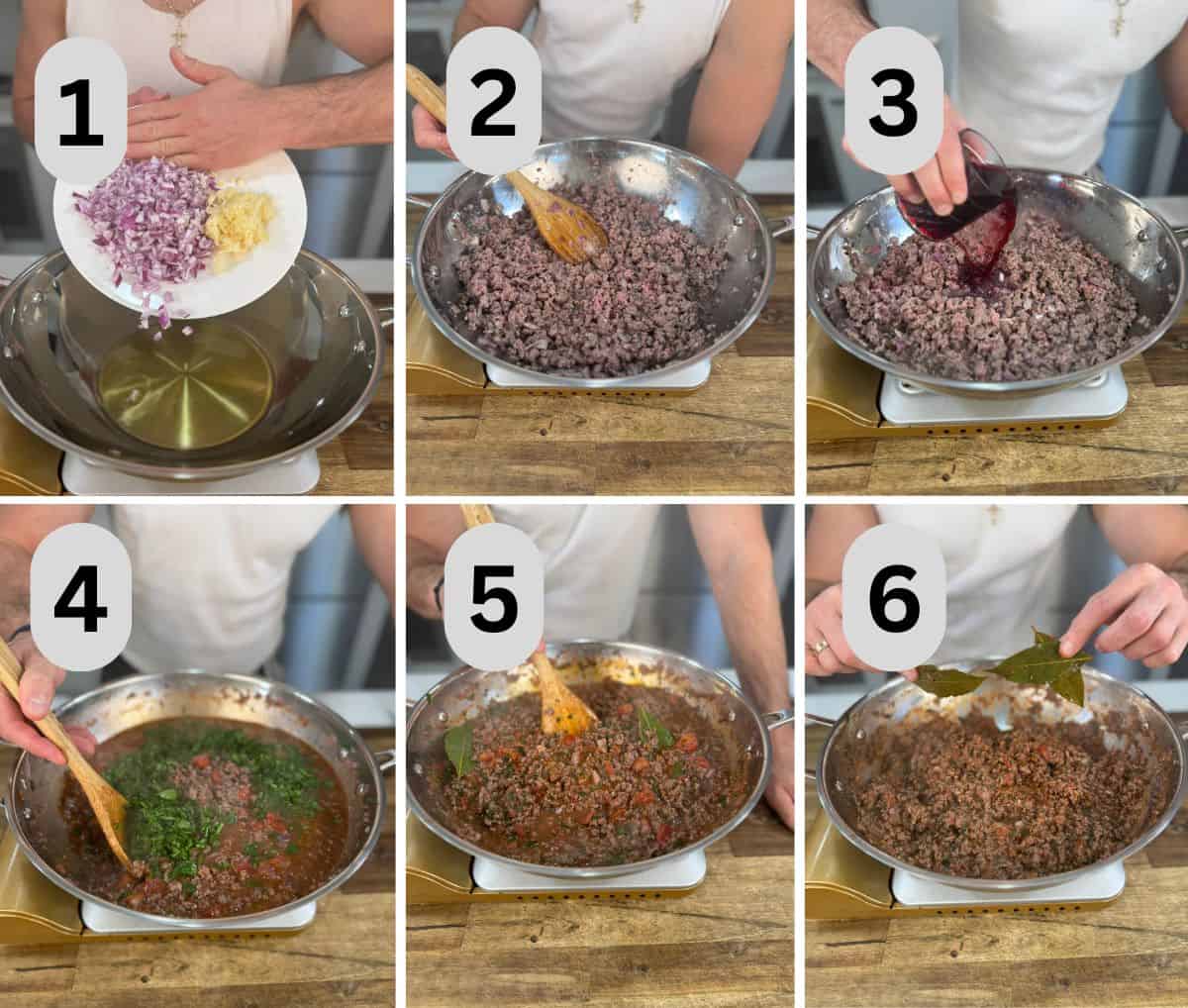
- In a large pot or wide pan over medium-high heat, add the olive oil, then toss in the red onion and garlic. Cook for a few minutes until they soften and smell amazing.
- Add in the ground meat and break it up with a wooden spoon as it cooks. Keep stirring until it browns all over and there are no red bits left.
- Pour in the red wine and let it simmer until the liquid reduces, which should take about 3 minutes.
- Stir in the crushed tomatoes, then add your spices, salt, sugar, bay leaves, and fresh parsley.
- Give everything a good mix, bring it to a gentle simmer, then reduce the heat and cook for roughly 15 minutes, stirring occasionally so nothing sticks.
- Once the liquids have reduced, take it off the heat and don’t forget to take out those bay leaves. Be patient with this step, we don’t want any excess liquid making the pastitsio too greasy.
Prepare the pasta
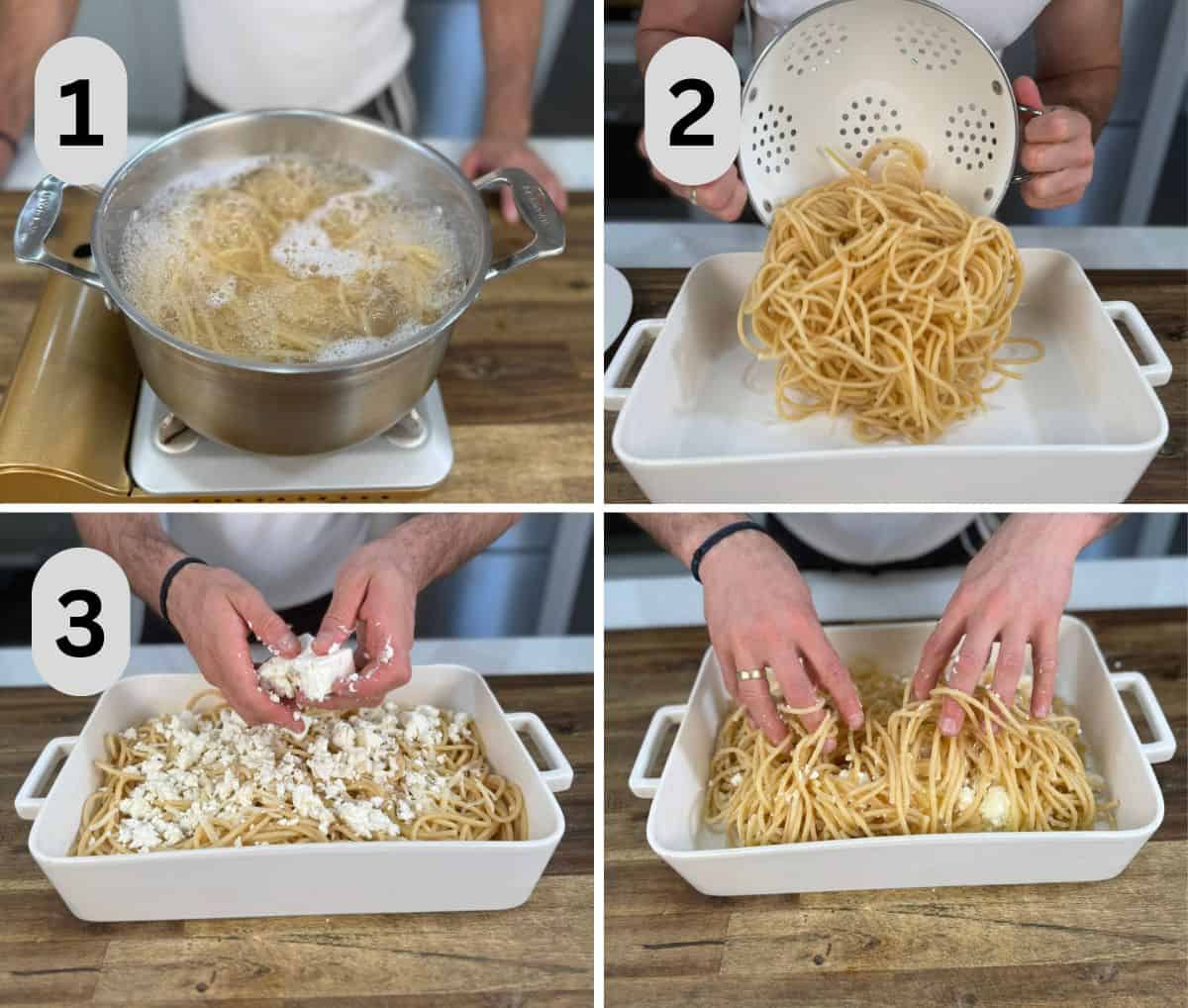
- Bring a large pot of salted water to a boil, then cook your tubular pasta according to the instructions on your brand, just until al dente.
- Drain the cooked pasta and tip it into your baking or casserole dish. I use a 36 cm x 24 cm dish, but anything close in size will do.
- Add the egg whites, crumbled feta, and grated Kefalograviera cheese, then gently toss everything together until it’s evenly combined.
- NOTE: Just be careful during mixing, as the pasta will still be hot, so don’t burn yourself. Use gloves or tongs if you need to.
Make the béchamel
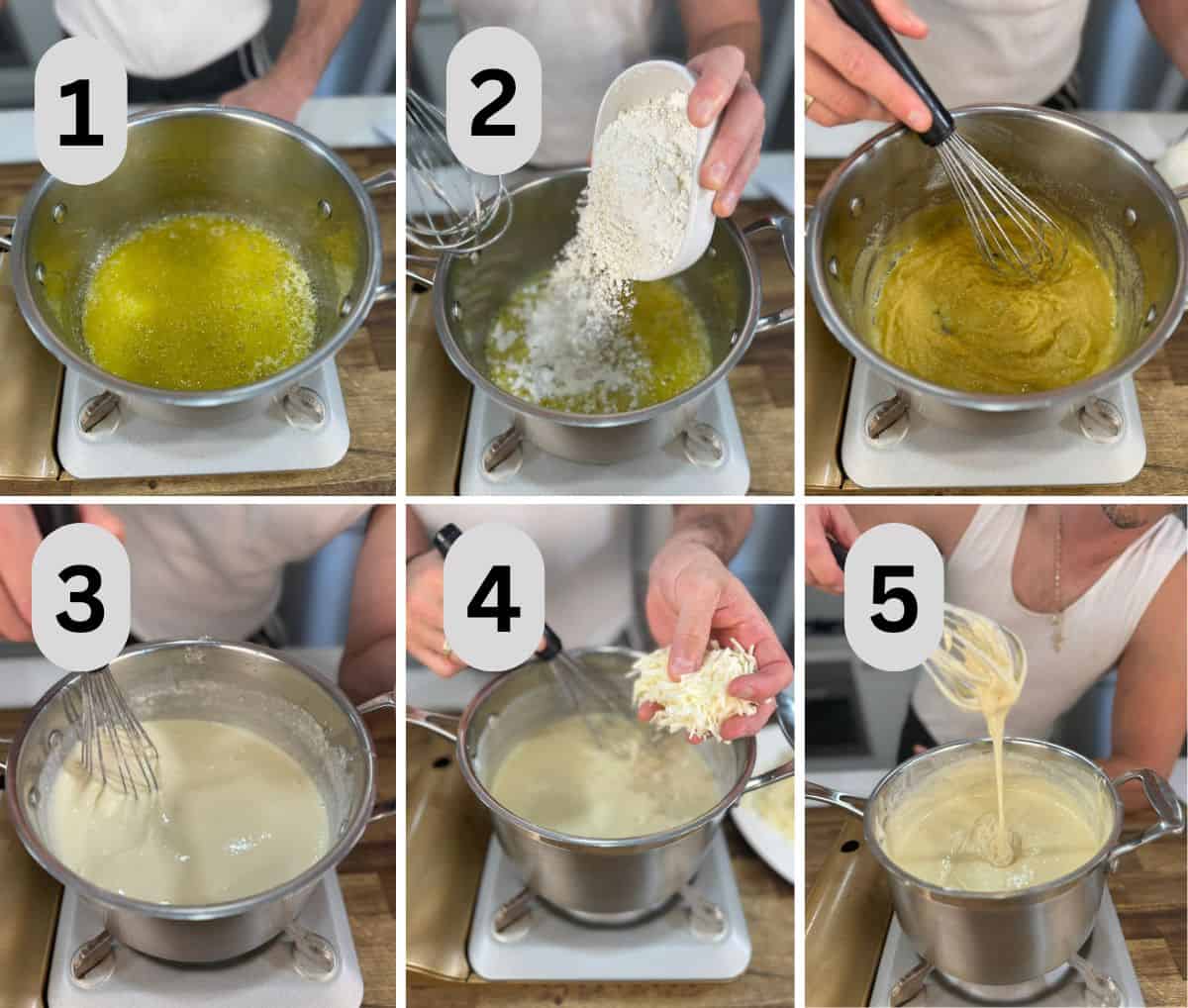
- In a large saucepan over medium heat, melt your unsalted butter.
- Sprinkle in the flour and whisk it through until a smooth paste forms.
- Slowly pour in the room temperature milk, whisking constantly little by little until the sauce thickens and becomes smooth and creamy.
- Add the egg yolks, a pinch of nutmeg, and your grated cheese.
- Keep whisking for another couple of minutes until the béchamel is thick, glossy, and just starting to bubble. Once it’s ready, take it off the heat.
Assemble and bake
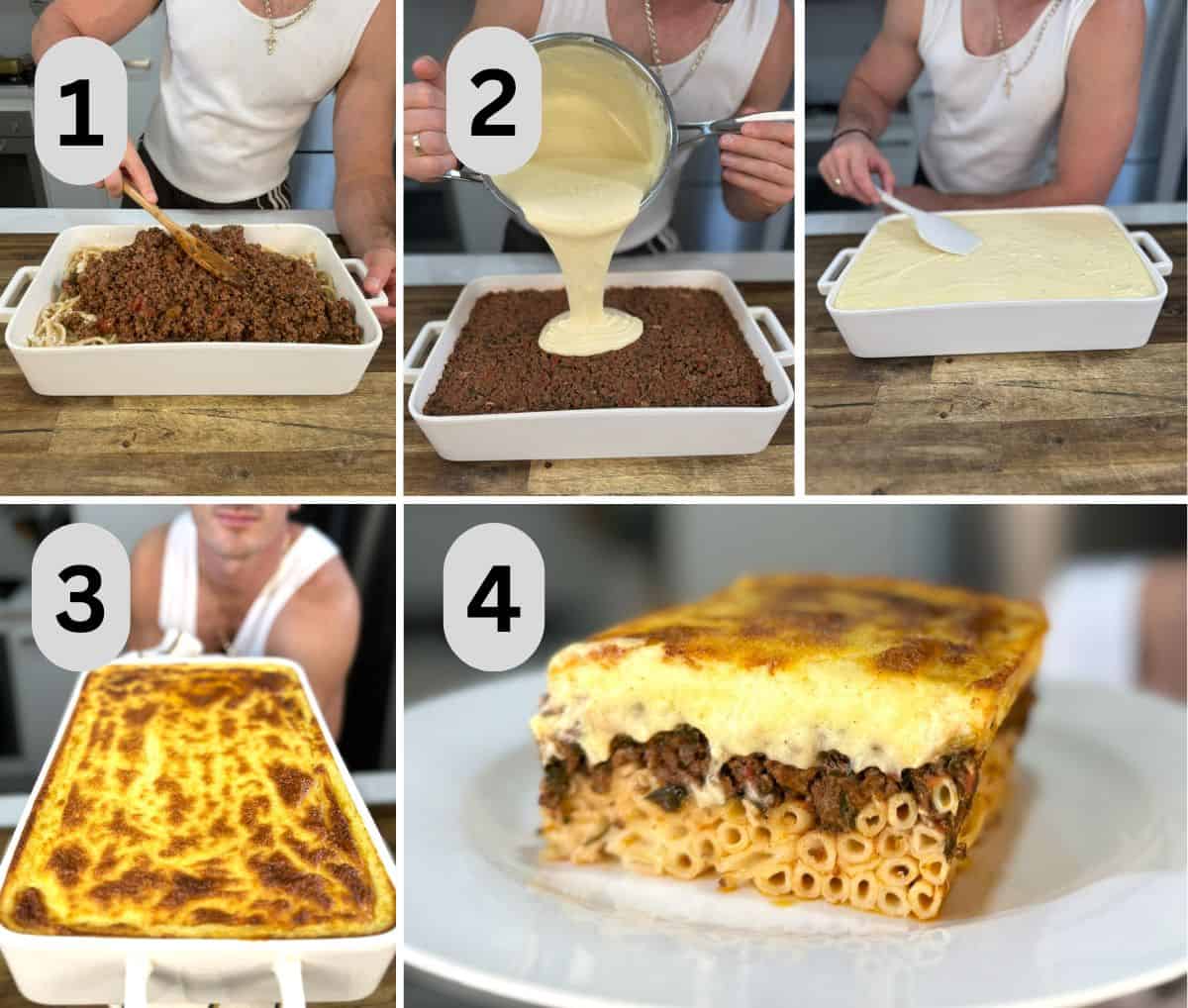
- Preheat your oven to 165°C fan-forced (330 °F), then spread the meat sauce evenly on top of the pasta. Use the back of a spoon to level it out.
- Pour the béchamel sauce over the top of the meat mixture and gently spread it right to the edges so the whole thing is covered in that creamy white sauce.
- Bake for 40 minutes, or until the top is golden brown. Keep an eye on it from the 30-minute mark, as every oven’s a bit different.
- Let it rest for at least 30 minutes before slicing. This helps everything set properly and gives you those neat, picture-perfect slabs.
Top tips
- Don’t rush the béchamel: Take your time when adding the milk. Pour it in gradually and keep whisking to avoid lumps. The slower you go, the smoother the sauce.
- Let it rest: This is one of the most important steps. Letting the pastitsio sit after baking gives the layers time to set. If you cut it too early, it’ll fall apart. Still delicious, just a bit messy.
- Use a sharp knife to slice: Sounds basic, but it makes all the difference. You want to see those distinct layers, and a clean, sharp knife helps you get those perfect slabs, just like you’d get at proper Greek restaurants.

Serving suggestions
- Salads: Serve it with a classic Greek salad or the famous Greek lettuce salad (maroulosalata). Both add freshness and help balance out the richness.
- Fresh bread: A slice of my easy crusty bread is perfect for mopping up all that extra meat sauce and béchamel, that’s the best part.
- Potatoes: Soft, zesty, Greek lemon potatoes that are full of flavour. A great way to bulk out the meal, especially if you’re feeding a crowd.
- Layered desserts: Finish strong with something sweet like sokolatina or ekmek kataifi! Both are rich, indulgent, and have three layers just like pastitsio.
Storage
Pastitsio is often even better the next day, with the flavours settling in beautifully. Leftover pastitsio can be stored in an airtight container in the fridge for up to 3 days, perfect for lunch or dinner later in the week.
Make-ahead
- You can fully assemble pastitsio up to 24 hours in advance. Just cover it well and keep it in the fridge until you're ready to bake.
Freezing
- Before baking: Let it cool completely, then wrap tightly and freeze for up to 2 months. Thaw in the fridge overnight, then bake as usual, but it may require a little bit extra cooking time.
- After baking: Let it cool, slice it into portions, and freeze the leftover pastitsio in airtight containers or well-wrapped.
Reheating
These instructions are for reheating fully cooked pastitsio that has been stored in the fridge or thawed.
- Oven reheating: Place one or more pieces in a baking dish and cover with foil. Reheat at 175°C (350°F) for roughly 30 minutes, or until heated through.
- Microwave reheating: Place a slice on a plate and heat on medium power for 2–3 minutes, checking if it's warmed through.

FAQ
Look for Kefalotyri or Kasseri. If you can’t find those, Parmesan or Pecorino Romano will also work just fine.
Traditional pastitsio is made with meat, but you can swap the beef for lentils, mushrooms, or mixed veggies. Just keep the seasoning strong to carry the dish.
Yes! You can use a non-alcoholic red wine, or substitute with beef stock. Both will keep the sauce rich, flavourful, and nicely balanced.




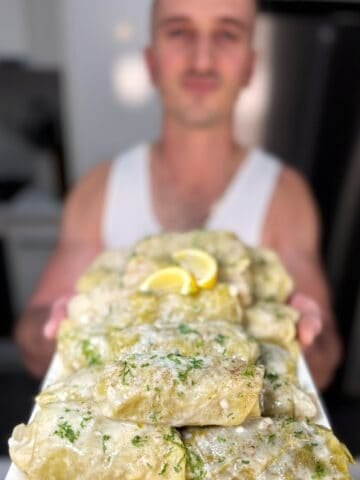
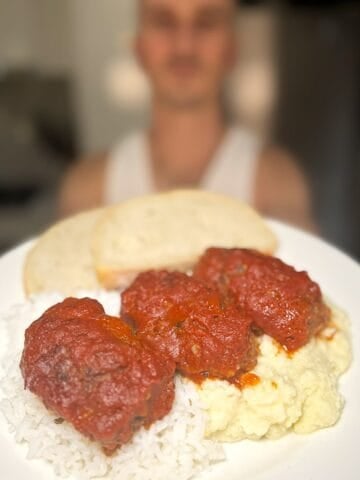
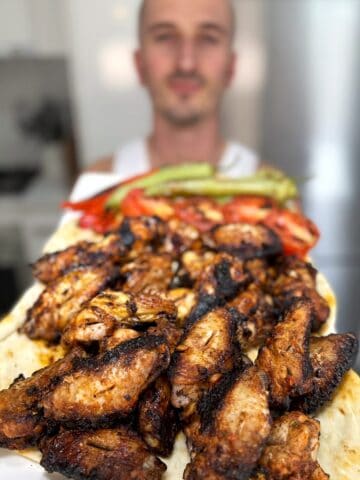

Panagiotis Spyridis says
I followed exactly your recipe and instructions and… it came out perfect. Thx.
P.S. I would do a cool off time of 25’-30’.
Nikolopaa says
Yiasou Panagioti! That's awesome glad it worked out well. Thank you 🙂 I have adjusted the time you are definitely correct. Makes it alot easier to cut and holds its shape much better 🙂
Danielle Alavaro says
This is hands down the best Pastitsio recipe I have ever made. My entire fussy family devour the whole tray. Each layer is packed of flavour that all compliments each other. Bloody beautiful for sure!
Nikolopaa says
Hey Danielle! I'm really happy that you all enjoyed and it even took care of the fussy ones 😉 Thanks for making my recipe and letting, and thanks for the comment 🙂
Tina Holland says
Hi Niko,
Just wanted to say thank you for your recipe, it’s absolutely superb. I made it for my dad’s 94th birthday and he loved it so much that he made me send him the recipe so he could send it to my aunties in Kastellorizo and Perth. I had to go to the ends of the earth to find the Kefalograviera but it was definitely worth it, everyone loved it. I’ve made a quite a few of your recipes now, they’re easy to follow, taste absolutely amazing and they’re bloody beautiful 😊
Nikolopaa says
Tina that is unreal! Happy 94th to your dad! Love that he’s spreading the recipe across Kastellorizo and Perth 😂. And respect for tracking down the Kefalograviera, that’s dedication! Thanks heaps for the kind words, seriously appreciate it, and I’m so glad you’re enjoying the recipes ❤️🙏
Claire Bakopoulos says
Nikoloppa is a famous name in our house and we love your recipes!! The kids ask for Pastitsio every week!! We love it, i make it for every occasion and our guests always love it too!!
Nikolopaa says
Haha love hearing that Claire! So glad the pastitsio is such a hit with the kids and the guests too 🙏 Really appreciate the support, and makes me happy to know the recipes are part of your family meals 🙏❤️
Hope says
Excellent. I replaced my previous recipe with yours. Used parmigiana from Italy. Thank you!!
Nikolopaa says
That means a lot Hope! And with proper parmigiana from Italy? That’s a top shelf pastitsio right there 🇮🇹🇬🇷🙌